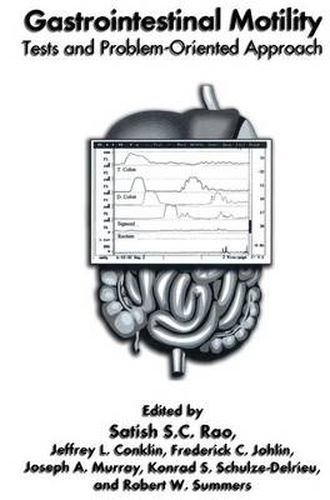Readings Newsletter
Become a Readings Member to make your shopping experience even easier.
Sign in or sign up for free!
You’re not far away from qualifying for FREE standard shipping within Australia
You’ve qualified for FREE standard shipping within Australia
The cart is loading…






This title is printed to order. This book may have been self-published. If so, we cannot guarantee the quality of the content. In the main most books will have gone through the editing process however some may not. We therefore suggest that you be aware of this before ordering this book. If in doubt check either the author or publisher’s details as we are unable to accept any returns unless they are faulty. Please contact us if you have any questions.
Gastrointestinal motility has evolved from an esoteric laboratory tool into a sophisti cated diagnostic technique that is now widely used clinically to guide in management of complex gastrointestinal problems. Today, it is the most rapidly growing subspecialty within gastroenterology. Previously, many of the gastrointestinal motility problems were either ignored or attributed to a disturbance of psyche. But with the growing knowledge and understanding of how a dysfunction of the gastrointestinal muscle and nerves can cause disease, we are at the threshold of a revolution in our approach to the diagnosis and treatment of gastrointestinal motility disorders. The purpose of this book is to serve as a useful, up-to-date reference manual and guide for the diagnostic and therapeutic approach towards common adult and pediatric gastrointestinal motility problems. In order to enhance the understanding of these disor ders, a problem-oriented approach has been chosen, and wherever possible the authors have provided clinical case scenarios to illustrate their message. The emphasis has been on how to diagnose and treat motility disorders rather than to provide an encyclopedic infor mation. The reference list at the end of each chapter should enable the enthusiast to seek further information. Some of the material presented in this book has been derived from the proceedings of the annual University ofIowa College of Medicine GI Motility Symposia.
$9.00 standard shipping within Australia
FREE standard shipping within Australia for orders over $100.00
Express & International shipping calculated at checkout
This title is printed to order. This book may have been self-published. If so, we cannot guarantee the quality of the content. In the main most books will have gone through the editing process however some may not. We therefore suggest that you be aware of this before ordering this book. If in doubt check either the author or publisher’s details as we are unable to accept any returns unless they are faulty. Please contact us if you have any questions.
Gastrointestinal motility has evolved from an esoteric laboratory tool into a sophisti cated diagnostic technique that is now widely used clinically to guide in management of complex gastrointestinal problems. Today, it is the most rapidly growing subspecialty within gastroenterology. Previously, many of the gastrointestinal motility problems were either ignored or attributed to a disturbance of psyche. But with the growing knowledge and understanding of how a dysfunction of the gastrointestinal muscle and nerves can cause disease, we are at the threshold of a revolution in our approach to the diagnosis and treatment of gastrointestinal motility disorders. The purpose of this book is to serve as a useful, up-to-date reference manual and guide for the diagnostic and therapeutic approach towards common adult and pediatric gastrointestinal motility problems. In order to enhance the understanding of these disor ders, a problem-oriented approach has been chosen, and wherever possible the authors have provided clinical case scenarios to illustrate their message. The emphasis has been on how to diagnose and treat motility disorders rather than to provide an encyclopedic infor mation. The reference list at the end of each chapter should enable the enthusiast to seek further information. Some of the material presented in this book has been derived from the proceedings of the annual University ofIowa College of Medicine GI Motility Symposia.